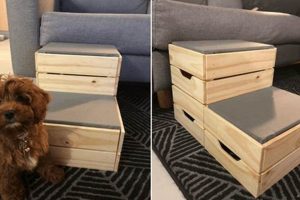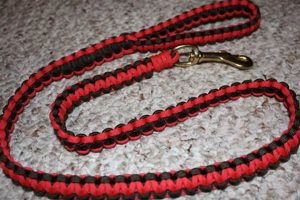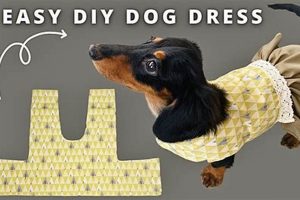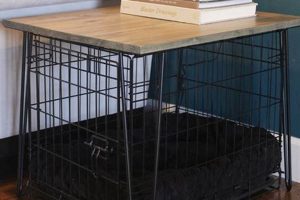A multi-tiered sleeping structure created by individuals for canine companions, typically constructed from readily available materials. These custom-built furnishings offer a space-saving solution, particularly beneficial in smaller living environments where multiple dogs reside. An example would be a wooden structure resembling a scaled-down human bunk bed, designed to provide separate, elevated resting areas for pets.
The appeal of crafting such a piece lies in its potential cost-effectiveness and the ability to personalize the design to suit specific canine needs and aesthetic preferences. Historically, pet owners have sought innovative ways to provide comfort and security for their animals, leading to the development of creative solutions like these. The creation of custom canine accommodations can also foster a stronger bond between owner and pet.
The following sections will explore material selection, construction techniques, design considerations, and safety precautions relevant to building such a structure. Emphasis will be placed on creating a functional and aesthetically pleasing furnishing that enhances both the dog’s well-being and the owner’s living space.
Construction Tips for Canine Multi-Level Sleep Structures
The following provides guidance for the construction of custom multi-tiered canine sleeping quarters. Prioritize safety and durability during the design and building phases.
Tip 1: Material Selection: Choose durable, non-toxic materials such as solid wood or plywood. Avoid treated lumber that may contain harmful chemicals. Ensure all materials are properly sanded to eliminate splinters.
Tip 2: Structural Integrity: Reinforce joints with screws, dowels, or metal brackets to ensure stability. The structure should withstand the combined weight of the intended canine occupants. Conduct thorough weight testing prior to allowing dogs to use the structure.
Tip 3: Size and Accessibility: Design each tier to comfortably accommodate the dog. Consider the dog’s age, breed, and mobility when determining height. Implement ramps or stairs if the upper tier is significantly elevated.
Tip 4: Bedding Considerations: Select appropriate bedding for each tier. Consider orthopedic beds for older dogs or those with joint problems. Ensure bedding is easily removable and washable for hygiene purposes.
Tip 5: Safety Rails and Barriers: Implement safety rails or barriers on the upper tier to prevent falls. The height of the barriers should be sufficient to deter jumping or accidental falls.
Tip 6: Finishing and Aesthetics: Apply a non-toxic sealant or paint to protect the wood and enhance the structure’s appearance. Consider the overall aesthetic of the room and choose finishes that complement the existing decor.
Tip 7: Ventilation and Airflow: Design the structure to allow for adequate ventilation. Ensure there is sufficient airflow between tiers to prevent overheating or accumulation of odors.
These tips emphasize creating a safe, functional, and comfortable environment for canine companions, prioritizing their well-being while maximizing space within the home.
The subsequent section will address specific design examples and advanced construction techniques to further refine the building process.
1. Dimensions
Dimensions are a critical determinant in the success and functionality of a homemade multi-tiered canine sleeping structure. The internal measurements of each tier must adequately accommodate the dog’s size, allowing ample room for the animal to stand, turn around, and lie down comfortably. Insufficient dimensions can lead to restricted movement, discomfort, and potentially, a reluctance to use the constructed space. Conversely, excessively large dimensions, while not inherently detrimental, may negate the space-saving purpose of a multi-tiered design. An example of poor dimensioning would be a lower tier too short for a large breed dog to stretch out, or an upper tier with insufficient height, causing the dog to hunch over. The consequence is an underutilized or rejected structure.
The dimensions must also account for bedding thickness. A thick dog bed will reduce the available vertical space, potentially creating a cramped environment. Furthermore, the overall external dimensions impact the structure’s footprint within the room. Careful planning is required to ensure the structure integrates seamlessly into the existing living space, avoiding obstruction or unnecessary spatial consumption. Ramps or stairs, if included, must adhere to appropriate angles and tread depths, relative to the dogs size and mobility, to prevent difficulty in ascending or descending. For instance, shallow, wide steps are often preferable for smaller breeds or senior dogs with joint issues.
In summary, the consideration of proper dimensions is paramount in the construction of a custom multi-tiered canine structure. The selection of appropriate internal and external measurements directly impacts the comfort, usability, and overall effectiveness of the design. Overlooking this crucial aspect can result in a structure that fails to meet its intended purpose, emphasizing the necessity for precise planning and execution. Challenges often arise when accommodating dogs of varying sizes or breeds within a single multi-tiered unit, requiring a compromise in dimensions or a custom-tailored approach for each canine occupant.
2. Materials
The selection of materials represents a foundational decision in the creation of a multi-tiered canine sleeping structure. The chosen materials directly influence the structure’s durability, safety, and aesthetic appeal. Inadequate material selection can compromise structural integrity, potentially leading to collapse or injury to the animal. For example, using untreated softwood, prone to splintering and rapid degradation, will result in a hazard. Conversely, the careful consideration of material properties and compatibility leads to a stable, long-lasting, and visually pleasing piece of canine furniture. The choice of materials also effects the overall cost of the multi tiered bed, therefore materials should be chosen while bearing the end budget in mind.
Considerations extend beyond structural integrity to encompass the animal’s health. Many commercially available wood treatments, paints, and adhesives contain volatile organic compounds (VOCs) that can pose a health risk to dogs through inhalation or ingestion. Therefore, opting for non-toxic, pet-safe alternatives is crucial. For instance, water-based stains and sealants, certified as low-VOC, provide a safer alternative to traditional solvent-based products. Furthermore, the surface texture of the chosen material plays a role in comfort. Smooth, easily cleaned surfaces promote hygiene, while rough or porous materials can harbor bacteria and odors. Bedding materials should be selected with equal care, prioritizing hypoallergenic, washable fabrics to minimize allergens and maintain cleanliness.
In summation, the materials employed in the construction of a multi-tiered canine sleeping structure are paramount to its success. The selection process must prioritize structural stability, canine safety, and aesthetic compatibility. Neglecting these aspects can lead to a structurally unsound, potentially harmful, and aesthetically unappealing result. By focusing on durable, non-toxic, and easily maintained materials, builders can create a canine furnishing that enhances both the animal’s well-being and the overall living environment.
3. Safety
The correlation between safety and multi-tiered canine sleeping structures is fundamentally defined by the inherent risks associated with elevated platforms and the potential for structural instability. The primary concern lies in preventing falls from upper tiers, which can result in injury, particularly for smaller breeds or dogs with pre-existing musculoskeletal conditions. Furthermore, the materials employed in construction can pose a threat if they are not non-toxic and pet-safe. An example is the use of pressure-treated lumber, which contains chemicals harmful to animals if ingested. Consequently, safety necessitates meticulous planning, careful material selection, and robust construction techniques.
The practical application of safety considerations involves implementing preventative measures throughout the construction process. Guardrails or barriers on upper tiers are essential to mitigate the risk of accidental falls. These barriers must be of sufficient height and strength to deter jumping or falling. The stability of the entire structure is paramount, requiring secure joinery, reinforced connections, and weight testing to ensure it can withstand the combined weight of the dogs intended to occupy it. In addition, incorporating features such as ramps or steps with appropriate inclines and slip-resistant surfaces facilitates easy access for dogs of varying ages and physical abilities. Failure to address these safety concerns can lead to preventable injuries and negate the benefits of a multi-tiered design.
In summary, the integration of safety into every facet of designing and building multi-tiered canine sleeping accommodations is non-negotiable. By prioritizing secure construction, non-toxic materials, and preventative measures such as guardrails and accessible ramps, builders can create a safe and comfortable environment for their canine companions. Addressing these considerations not only safeguards the dogs’ physical well-being but also ensures the long-term functionality and success of the constructed structure. The challenges inherent in designing for canine safety highlight the need for informed decision-making and a commitment to prioritizing the animal’s welfare above all else.
4. Stability
Stability, in the context of a self-constructed multi-tiered canine sleeping structure, constitutes a foundational element impacting both the immediate safety and long-term usability of the item. A lack of structural integrity can lead to collapse, resulting in potential injury to the dog. Therefore, meticulous attention to stability is paramount during the design and construction phases.
- Joint Integrity
The method of joining structural components directly affects overall stability. Weak or poorly executed joints, such as those relying solely on adhesives without mechanical fasteners, are prone to failure under stress. Examples of stable joints include mortise and tenon, dovetail, or reinforced screw connections. The use of metal brackets or corner braces can further enhance joint strength. Failure to prioritize joint integrity compromises the entire structure’s load-bearing capacity, increasing the risk of collapse.
- Material Load Capacity
Each material possesses a specific load capacity, representing the maximum weight it can bear before deformation or failure. Selecting materials with insufficient load-bearing capacity for the intended canine occupants compromises stability. For instance, thin plywood or untreated softwood may buckle under the weight of a larger dog. Proper material selection involves calculating the anticipated load and choosing materials with appropriate strength and rigidity. Over-engineering the structure, by using materials with higher load capacities than strictly necessary, provides an added margin of safety.
- Base Support and Distribution
The base of the structure serves as the foundation, distributing the weight evenly across the supporting surface. An inadequate base, characterized by insufficient contact points or uneven weight distribution, can result in instability. Examples of stable base designs include solid platforms, widely spaced legs, or adjustable leveling feet to compensate for uneven floors. Uneven weight distribution can induce stress points, leading to structural failure. A stable base ensures that the entire structure remains upright and prevents tipping, especially during canine movement or play.
- Center of Gravity
The center of gravity represents the point at which the weight of the structure is evenly distributed. A high center of gravity increases the risk of tipping, especially with dynamic loads such as a dog jumping onto or off the upper tiers. Lowering the center of gravity, by placing heavier components near the base and ensuring a wide base of support, enhances stability. Strategic placement of internal supports can also redistribute weight and lower the center of gravity. An unstable center of gravity can render the structure prone to accidental tipping, posing a safety hazard to the canine occupant.
These facets, when addressed comprehensively, contribute to the creation of a multi-tiered canine sleeping structure with adequate stability. The absence of any of these considerations can compromise the overall structural integrity, leading to potential hazards. Consequently, diligent planning, precise execution, and ongoing monitoring are crucial for maintaining stability and ensuring the safety of the animal.
5. Accessibility
Accessibility, within the context of self-constructed multi-tiered canine sleeping structures, denotes the ease with which a dog can utilize all levels of the structure. This is a critical design consideration directly impacting the structure’s usability and the dog’s overall comfort and safety. Failure to address accessibility limitations can render certain tiers unusable, particularly for dogs with physical limitations.
- Ramp Inclination and Design
The angle and design of ramps significantly influence accessibility. Steeper inclines pose challenges for smaller breeds, senior dogs, or those with joint issues. Shallow inclines are generally preferable, but excessively long ramps may consume too much space. Ramp surfaces must provide adequate traction to prevent slipping. Examples of accessible ramp designs include those with low-pile carpeting or textured surfaces. Inadequate ramp design can effectively bar dogs from accessing upper tiers, negating the purpose of the multi-tiered structure.
- Step Height and Tread Depth
When stairs are incorporated, step height and tread depth determine the ease of ascent and descent. High steps are difficult for smaller dogs and those with limited mobility. Shallow tread depths offer insufficient space for paws, increasing the risk of falls. Optimal step design features low risers and deep treads, providing a stable and secure climbing surface. The absence of proper step dimensions can render the stairs unusable for certain dogs, limiting access to the upper levels.
- Tier Height and Clearances
The height of each tier, along with the available headroom within, dictates the dog’s ability to comfortably enter and exit each level. Low clearances may require dogs to crouch or contort their bodies, leading to discomfort or injury. Excessive tier heights, particularly for the upper level, increase the risk of falls. Appropriate tier heights and clearances ensure that dogs can easily navigate each level without physical strain. Improper tier height and clearance can cause discomfort and injury for the animal.
- Material and Surface Texture
The materials used to construct ramps and stairs, along with their surface texture, influence grip and stability. Slippery surfaces, such as polished wood or smooth plastic, increase the risk of falls. Textured materials, such as carpet or rubberized surfaces, provide improved traction. In addition, ramps must have appropriate reinforcement to prevent sagging under a dog’s weight. Material choice thus contributes to the general safety and ease of access.
These accessibility considerations directly impact the utility and safety of the self-constructed multi-tiered canine sleeping structure. Neglecting any of these elements can limit a dog’s ability to fully utilize the designed space, undermining the structure’s purpose. Careful planning and attention to detail are crucial to ensure that the finished product is accessible and beneficial for dogs of all ages and physical abilities.
6. Ventilation
Adequate airflow within a self-constructed multi-tiered canine sleeping structure, frequently overlooked, directly impacts the animal’s health and comfort. Inadequate ventilation creates an environment conducive to the accumulation of stale air, odors, and potential allergens. This environment is detrimental to canine respiratory health and overall well-being. A common consequence of poor ventilation is increased humidity, fostering the growth of mold and bacteria, which can exacerbate allergies and respiratory issues. For example, an enclosed lower tier lacking ventilation can rapidly become a stagnant environment, particularly in warmer climates, resulting in discomfort and potential health problems for the dog.
The design of the structure necessitates the inclusion of ventilation features to mitigate these risks. Openings or vents strategically placed throughout the structure promote airflow, preventing the build-up of stagnant air. The size and placement of these vents should be carefully considered to ensure adequate circulation without compromising structural integrity or creating drafts. Furthermore, the choice of materials impacts ventilation; breathable materials, such as untreated wood, allow for some degree of air exchange, while non-porous materials, such as plastic, can exacerbate ventilation problems. Implementing simple design modifications, such as incorporating mesh panels or strategically positioned openings, can significantly improve airflow within each tier. Regular cleaning of the structure and bedding materials also aids in maintaining good ventilation and preventing the accumulation of allergens and odors.
In conclusion, ventilation is a critical component in the design and construction of a multi-tiered canine sleeping structure. Prioritizing adequate airflow safeguards the animal’s health and comfort, preventing the build-up of stale air, odors, and potential allergens. Neglecting this aspect can lead to a compromised environment detrimental to canine well-being. Thoughtful design, material selection, and regular maintenance contribute to creating a well-ventilated and healthy space for canine companions.
Frequently Asked Questions
The following addresses common inquiries regarding the construction, maintenance, and safety of custom-built canine multi-tiered sleeping arrangements. This information aims to provide clarity and guidance for individuals considering this type of project.
Question 1: What is the recommended height for safety rails on the upper tier of a canine bunk bed?
The generally accepted minimum height for safety rails is half the height of the dog. The rail height should be sufficient to discourage jumping and prevent accidental falls while allowing the dog to look over the edge. Additional horizontal bars may be added to the safety rails if the vertical bar spacing exceeds four inches, preventing a small dog from squeezing through.
Question 2: Which wood types are most suitable for constructing a durable canine bunk bed?
Hardwoods, such as oak, maple, and birch, provide superior strength and durability compared to softwoods. However, due to cost considerations, high-quality plywood, properly sealed, is an acceptable alternative. Regardless of wood type, all surfaces must be sanded to a smooth finish to prevent splinters.
Question 3: What are the key considerations when designing ramps or stairs for a canine bunk bed?
Ramp inclines should be gradual, ideally less than 25 degrees, to accommodate dogs with limited mobility. Stair steps should have a low rise (no more than six inches) and a deep tread (at least 10 inches) to provide ample space for paws. Incorporating a non-slip surface, such as carpet or rubberized material, enhances traction and prevents falls.
Question 4: How can the weight capacity of a canine bunk bed be accurately assessed?
The weight capacity must exceed the combined weight of the dogs anticipated to occupy the structure. Test the structure by incrementally adding weight, observing for any signs of bending, creaking, or instability. Consult engineering resources for appropriate load-bearing calculations based on material specifications and joint design. Weight testing should be done before the dogs can use the bed.
Question 5: What cleaning products are safe for use on a canine bunk bed?
Avoid harsh chemicals or abrasive cleaners that can damage the finish or pose a health risk to dogs. Opt for mild, non-toxic cleaning solutions specifically formulated for pet use. Regularly vacuum or wipe down the structure to remove pet dander and debris. Steam cleaning may be employed for deep cleaning but avoid excessive moisture.
Question 6: How can proper ventilation be ensured in a canine bunk bed with enclosed tiers?
Incorporate ventilation openings on the sides or back of each tier to promote airflow. The size and number of openings should be sufficient to prevent the accumulation of stagnant air. Consider using breathable bedding materials to further enhance ventilation. Place the bed in a location that facilitates natural air circulation.
The considerations mentioned herein represent essential aspects of crafting safe and functional multi-tiered sleeping accommodations for canine companions.
The following section will offer advanced building techniques and design inspirations for custom canine structures.
diy dog bunk bed
This exploration of the self-assembled canine multi-tiered sleeping arrangement has underscored critical elements ranging from material selection and structural stability to canine safety and overall utility. The successful construction of such a piece demands meticulous planning, precise execution, and a comprehensive understanding of canine needs and environmental considerations. Key points reiterated include the paramount importance of non-toxic materials, secure joinery, appropriate dimensions, and accessible designs, all contributing to a structure that is both safe and functional for its intended occupants.
The pursuit of providing enhanced comfort and spatial optimization for canine companions through the creation of a do-it-yourself sleeping structure is a commendable endeavor. It requires the maker to prioritize the animal’s well-being while simultaneously demonstrating ingenuity and craftsmanship. Potential builders are encouraged to apply the principles discussed, ensuring the resulting structure serves as a testament to both their skills and their commitment to responsible pet ownership. The significance of diligent research and careful consideration throughout the building process cannot be overstated.







![Build a Safe Sliding Dog Gate DIY [Easy Steps!] The DIY Hub: Creative Crafts, Repairs & Life Hacks Build a Safe Sliding Dog Gate DIY [Easy Steps!] | The DIY Hub: Creative Crafts, Repairs & Life Hacks](https://craftingdiycenter.com/wp-content/uploads/2025/07/th-2861-300x200.jpg)